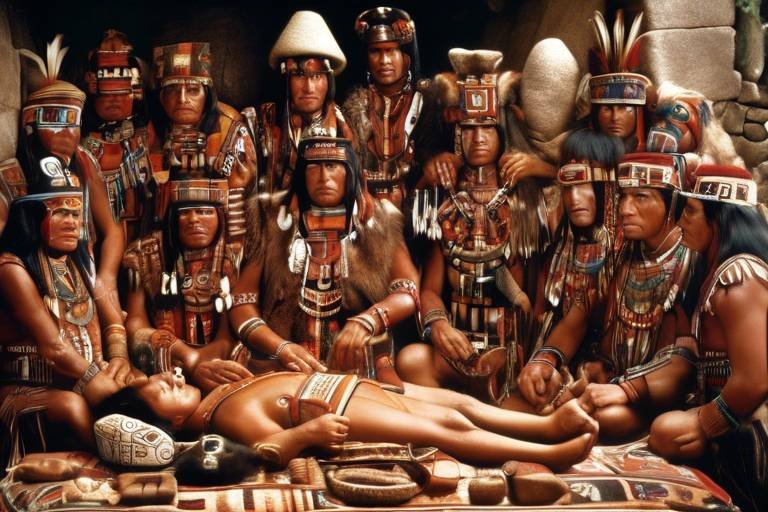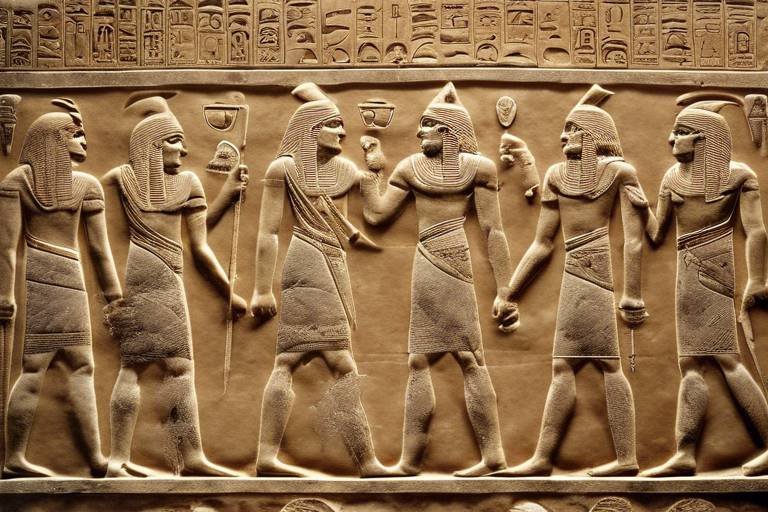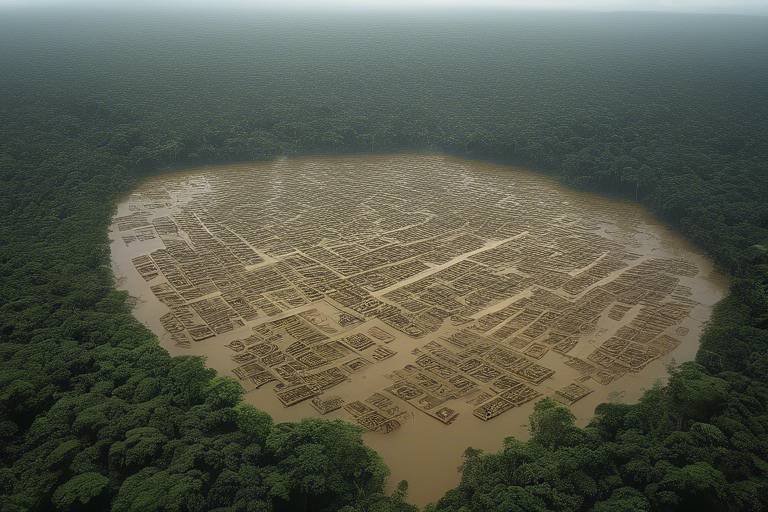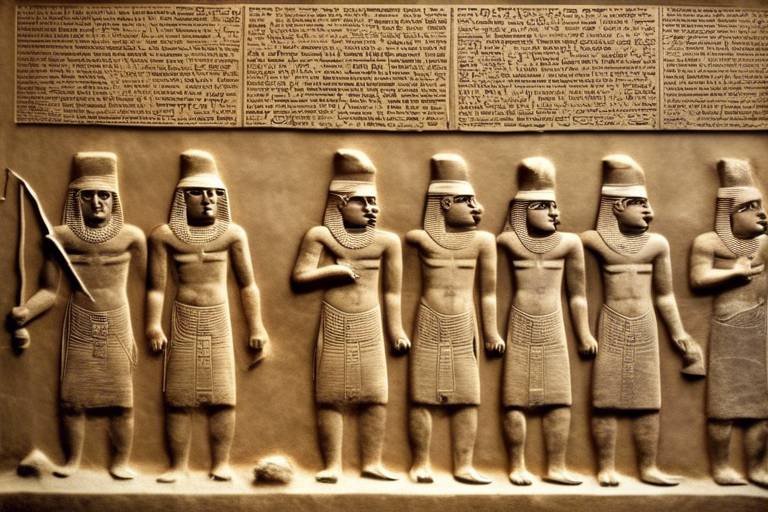The Mystery of the Lost Civilizations of Central America
Central America is a land shrouded in mystery, where ancient civilizations once thrived before vanishing into the depths of history, leaving behind tantalizing clues and unanswered questions. The enigmatic disappearance of these cultures has captivated archaeologists and historians for centuries, sparking a quest to uncover the secrets of the lost civilizations that once flourished in this region.
Among these intriguing societies were the Olmec civilization, known for their iconic colossal stone heads that stand as silent sentinels to a bygone era. The Olmec people laid the groundwork for the sophisticated Mesoamerican societies that followed, leaving a legacy of art, religion, and societal organization that continues to intrigue researchers to this day.
One of the most renowned civilizations of Central America was the mighty Maya Empire, with its grand cities, intricate calendar system, and enigmatic collapse. The Maya's architectural marvels and advanced knowledge in astronomy and mathematics attest to their intellectual prowess, yet the reasons behind the abandonment of their urban centers remain a subject of intense debate.
The Aztec civilization, centered around the majestic city of Tenochtitlan, thrived through innovative agricultural practices and a complex social hierarchy. However, the arrival of Spanish conquistadors marked the beginning of the end for the Aztec empire, as disease, warfare, and colonization reshaped the fate of this once-powerful civilization.
Further south, in Oaxaca, Mexico, the Zapotec culture flourished, leaving behind the impressive ruins of Monte Albán and a sophisticated writing system that continues to baffle scholars. The intricate societal organization of the Zapotec people hints at a complex civilization with advanced knowledge in art, architecture, and governance.
Amidst these ancient wonders lies the enigmatic city of Teotihuacan, a vast urban center in Mexico with monumental pyramids and a meticulously planned layout. The sudden decline of Teotihuacan remains a mystery, with theories ranging from internal strife to environmental catastrophes, keeping researchers intrigued by the secrets buried beneath its ancient stones.
As we delve into the mysteries of the lost civilizations of Central America, we confront a tapestry of cultures that rose to great heights only to vanish into obscurity. Through ongoing archaeological discoveries and meticulous research, we continue to unravel the intricate web of history that connects us to these ancient peoples, shedding light on their achievements, struggles, and ultimate fate.

The Olmec Civilization
The Olmec civilization, often referred to as the "Mother Culture" of Mesoamerica, thrived in what is now present-day Mexico from around 1400 BCE to 400 BCE. They are best known for their colossal stone heads, weighing several tons each, which depict distinct human faces with unique features. These monumental sculptures stand as a testament to the artistic and engineering prowess of the Olmec people.
Beyond their impressive stone monuments, the Olmec civilization laid the foundation for subsequent Mesoamerican societies through their advanced culture. They developed complex agricultural practices, including the cultivation of maize, beans, and squash, which formed the basis of their diet. Additionally, the Olmecs engaged in long-distance trade, exchanging goods such as jade, obsidian, and ceramics with neighboring cultures.
The Olmec society was characterized by social hierarchy, with distinct classes and specialized roles within their communities. They were skilled artisans, creating intricate pottery, figurines, and jewelry adorned with symbolic motifs that reflected their spiritual beliefs. The Olmecs also had a sophisticated understanding of astronomy and developed a calendar system that influenced later Mesoamerican civilizations.
Despite their significant contributions to the cultural landscape of Central America, the decline of the Olmec civilization remains a mystery. The reasons behind their eventual disappearance from the historical record are still debated among archaeologists and historians. Some theories suggest environmental factors, such as volcanic eruptions or climate change, while others point to internal conflicts or external invasions.

The Maya Empire
The Maya Empire, one of the most fascinating ancient civilizations in Central America, captivates historians and archaeologists with its grandeur and mysteries. Flourishing in the lush jungles of present-day Mexico, Guatemala, Belize, and Honduras, the Maya people built magnificent cities adorned with intricate stone temples and palaces. Their advanced knowledge in astronomy led to the creation of a sophisticated calendar system that still astounds scholars today.
However, the enigmatic collapse of the Maya Empire continues to puzzle researchers. The once-thriving urban centers, such as Tikal and Palenque, were mysteriously abandoned, leaving behind haunting remnants of a once-great civilization. Was it due to environmental degradation, internal conflicts, or a combination of factors that led to their downfall?
Moreover, the Maya's intricate hieroglyphic writing system provides a glimpse into their rich culture and history. Recent archaeological discoveries have unveiled new insights into their societal structure, religious practices, and trade networks. The Maya's legacy in mathematics, art, and architecture reverberates through time, influencing modern society in ways we may not even realize.
As we unravel the secrets of the Maya Empire, we are confronted with more questions than answers. What drove the Maya to build such awe-inspiring cities? How did their sophisticated society crumble into obscurity? The allure of the Maya civilization beckons us to delve deeper into its mysteries, sparking our curiosity and igniting our imagination.

The Aztec Civilization
Let's delve into the fascinating world of the Aztec civilization, a remarkable society that flourished in Central America. The Aztecs are renowned for their capital city of Tenochtitlan, which was built on an island in the middle of Lake Texcoco. This strategic location not only provided natural defenses but also showcased the engineering prowess of the Aztec people in creating a thriving urban center amidst the waters.
One of the most intriguing aspects of the Aztec civilization was their advanced agricultural techniques. The Aztecs ingeniously utilized chinampas, artificial islands made from mud and vegetation, to cultivate crops such as maize, beans, and squash. This innovative method allowed them to sustain a large population in a relatively small area, demonstrating their ingenuity in adapting to the challenging environment.
Moreover, the Aztecs had a complex social structure that encompassed various classes, from rulers and priests to artisans and farmers. The society was hierarchical, with strict roles and responsibilities assigned to each individual based on their lineage and occupation. This intricate system ensured the functioning of the Aztec state and the maintenance of order within their vast empire.
However, the glory of the Aztec civilization was overshadowed by the arrival of the Spanish conquistadors led by Hernán Cortés. The encounter between the Aztecs and the Spanish marked a tumultuous period in history, culminating in the fall of Tenochtitlan in 1521. The conquest of the Aztec Empire by the Spanish conquistadors led to the eventual demise of this once-mighty civilization.

The Zapotec Culture
The Zapotec culture, originating in Oaxaca, Mexico, is a fascinating civilization that flourished in ancient Mesoamerica. Known for their remarkable achievements in various fields, the Zapotecs left a lasting legacy that continues to intrigue historians and archaeologists alike.
One of the most notable aspects of the Zapotec culture is the impressive archaeological site of Monte Albán. This ancient city served as the political and religious center of the Zapotec civilization, showcasing their architectural prowess and urban planning expertise. The layout of Monte Albán reflects the Zapotecs' advanced knowledge of astronomy and mathematics, evident in the alignment of structures with celestial events.
Furthermore, the Zapotecs developed a sophisticated writing system known as the Zapotec script. This unique form of communication allowed them to record historical events, religious practices, and societal organization, providing valuable insights into their culture and beliefs.
The societal structure of the Zapotec civilization was complex and hierarchical, with distinct social classes and specialized roles within the community. Priests, rulers, artisans, and farmers played essential roles in maintaining the stability and prosperity of Zapotec society, contributing to its overall advancement and prosperity.
Through their intricate artwork, including pottery, sculpture, and jewelry, the Zapotecs expressed their cultural identity and artistic sophistication. These artifacts not only showcase the craftsmanship and creativity of the Zapotec people but also offer valuable clues about their daily life, rituals, and worldview.
Despite the impressive achievements of the Zapotec culture, much about their history and ultimate fate remains shrouded in mystery. The enigmatic decline of Monte Albán and the gradual disappearance of Zapotec influence raise intriguing questions about the factors that led to the decline of this once-thriving civilization.
In conclusion, the Zapotec culture stands as a testament to the ingenuity and creativity of ancient Mesoamerican civilizations. By unraveling the mysteries of the Zapotecs, researchers continue to gain valuable insights into the rich tapestry of Central American history and the enduring legacy of these remarkable people.

The Teotihuacan Mystery
Exploring the enigmatic disappearance of ancient civilizations in Central America and the lingering questions surrounding their existence and demise.
Teotihuacan, a majestic ancient city in Mexico, continues to puzzle archaeologists and historians alike with its grandeur and sudden decline. The city's monumental pyramids, meticulously planned urban layout, and advanced infrastructure hint at a sophisticated society that thrived in the distant past. Yet, the reasons behind its eventual downfall remain elusive, leaving researchers to speculate on the enigmatic fate of this once-flourishing civilization.

The Mysterious Collapse
As we delve into the annals of history, the enigmatic disappearance of once-thriving civilizations in Central America poses a perplexing puzzle that continues to intrigue scholars and enthusiasts alike. The sudden collapse of these ancient societies, including the Olmec, Maya, Aztec, Zapotec, and Teotihuacan, raises numerous questions about the factors that led to their downfall.
One of the prevailing theories surrounding the mysterious collapse of these civilizations revolves around environmental degradation. The relentless exploitation of natural resources, deforestation, and unsustainable agricultural practices may have contributed to ecological imbalances that ultimately led to societal collapse. Could the relentless pursuit of resources have triggered a chain reaction that spelled doom for these advanced cultures?
Warfare and internal conflicts also loom large as potential catalysts for the downfall of Central American civilizations. The constant struggle for power, territory, and resources among rival factions could have plunged these once-mighty empires into a state of perpetual conflict, sowing the seeds of their eventual demise. Were these civilizations torn apart by internal strife, unable to withstand the pressures of incessant warfare?
Moreover, the introduction of new diseases by European colonizers had a devastating impact on indigenous populations, decimating their numbers and weakening the social fabric of these ancient societies. The arrival of foreign diseases, to which the native populations had no immunity, wreaked havoc and accelerated the decline of these once-flourishing civilizations. Could the invisible threat of disease have been the silent harbinger of their collapse?
The specter of European colonization looms large over the fate of Central American civilizations, as the arrival of Spanish conquistadors brought about a seismic shift in power dynamics. The brutal conquest and subjugation of indigenous peoples, coupled with the imposition of foreign rule and religious beliefs, irrevocably altered the course of history for these ancient cultures. How did the clash of civilizations with vastly disparate technologies and worldviews shape the destiny of Central America?
As we strive to unravel the mysteries surrounding the collapse of these lost civilizations, it becomes evident that a multitude of factors, ranging from environmental pressures to external invasions, played a role in their downfall. The echoes of the past reverberate through the corridors of time, reminding us of the fragility of human endeavors and the impermanence of even the most grandiose civilizations.

Archaeological Discoveries
Exploring the enigmatic disappearance of ancient civilizations in Central America and the lingering questions surrounding their existence and demise.
Unraveling the secrets of the Olmec civilization, known for their colossal stone heads and advanced culture that laid the foundation for Mesoamerican societies.
Delving into the rise and fall of the Maya Empire, renowned for their impressive cities, sophisticated calendar system, and mysterious abandonment of urban centers.
Examining the Aztec civilization, with its capital city of Tenochtitlan, advanced agriculture techniques, intricate social structure, and eventual conquest by the Spanish conquistadors.
Discovering the Zapotec culture of Oaxaca, Mexico, characterized by their impressive Monte Albán site, advanced writing system, and complex societal organization.
Uncovering the enigma of Teotihuacan, a vast ancient city in Mexico with monumental pyramids, intricate urban planning, and a sudden decline that remains shrouded in mystery.
Investigating the possible reasons behind the collapse of these once-great civilizations, including environmental factors, warfare, disease, and the impact of European colonization.
Recent archaeological findings have been instrumental in shedding light on the lost civilizations of Central America. Excavations at various sites have revealed intricate artifacts, such as pottery, sculptures, and hieroglyphic inscriptions, providing valuable insights into the daily lives, religious practices, and technological advancements of these ancient cultures.
Moreover, the discovery of burial sites and architectural remains has offered clues about the societal structure, burial practices, and urban planning of these civilizations. Researchers have also unearthed evidence of trade networks, agriculture techniques, and artistic expressions, enriching our understanding of the interconnectedness and creativity of these ancient societies.
Through advanced scientific techniques, such as carbon dating, DNA analysis, and remote sensing technologies, archaeologists have been able to reconstruct the timelines of these civilizations, identify migration patterns, and unravel the mysteries surrounding their sudden decline. These breakthroughs in archaeological research continue to reshape our perceptions of Central American history and challenge previous assumptions about the capabilities and achievements of these lost civilizations.
Exploring the enduring legacy of Central American civilizations on modern society, including their contributions to art, architecture, agriculture, mathematics, and spirituality.

Legacy and Cultural Influence
Exploring the enigmatic disappearance of ancient civilizations in Central America and the lingering questions surrounding their existence and demise.
Unraveling the secrets of the Olmec civilization, known for their colossal stone heads and advanced culture that laid the foundation for Mesoamerican societies.
Delving into the rise and fall of the Maya Empire, renowned for their impressive cities, sophisticated calendar system, and mysterious abandonment of urban centers.
Examining the Aztec civilization, with its capital city of Tenochtitlan, advanced agriculture techniques, intricate social structure, and eventual conquest by the Spanish conquistadors.
Discovering the Zapotec culture of Oaxaca, Mexico, characterized by their impressive Monte Albán site, advanced writing system, and complex societal organization.
Uncovering the enigma of Teotihuacan, a vast ancient city in Mexico with monumental pyramids, intricate urban planning, and a sudden decline that remains shrouded in mystery.
Investigating the possible reasons behind the collapse of these once-great civilizations, including environmental factors, warfare, disease, and the impact of European colonization.
Highlighting recent archaeological findings and ongoing research that shed light on the lost civilizations of Central America, providing new insights into their culture, technology, and ultimate fate.
Exploring the enduring legacy of Central American civilizations on modern society, including their contributions to art, architecture, agriculture, mathematics, and spirituality.
Stay tuned for answers to commonly asked questions about the lost civilizations of Central America!
Frequently Asked Questions
- What caused the mysterious disappearance of the ancient civilizations in Central America?
The exact reasons for the disappearance of these civilizations remain a subject of debate among historians and archaeologists. Factors such as environmental changes, warfare, disease, and the impact of European colonization are believed to have played a role in their downfall.
- What are some notable features of the Olmec civilization?
The Olmec civilization is renowned for its massive stone heads, advanced art and culture, and influence on later Mesoamerican societies. They were among the first complex societies in the region and laid the foundation for subsequent civilizations.
- What is the significance of the Maya calendar system?
The Maya calendar system is highly advanced and accurate, reflecting their deep understanding of astronomy and mathematics. It consisted of various interlocking calendars that were used for religious ceremonies, agricultural practices, and predicting celestial events.
- How did the Aztec civilization come to an end?
The Aztec civilization met its demise with the arrival of Spanish conquistadors led by Hernan Cortes. The capital city of Tenochtitlan was conquered in 1521, marking the end of Aztec rule in Mesoamerica.
- What is the significance of Teotihuacan in Central American history?
Teotihuacan was a major ancient city in Mexico known for its monumental pyramids, urban planning, and mysterious decline. It was one of the largest cities in the pre-Columbian Americas and influenced later civilizations in the region.


















